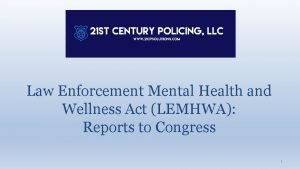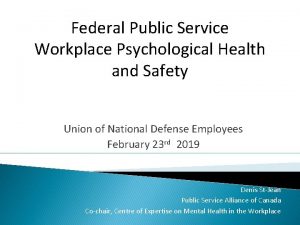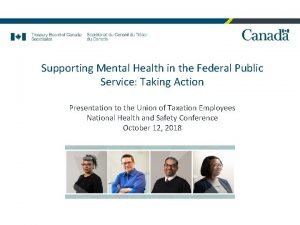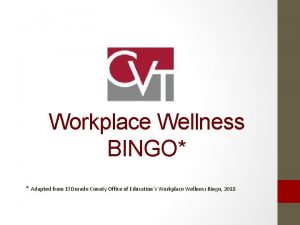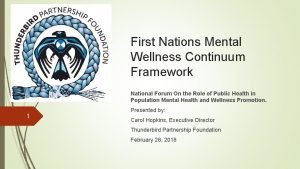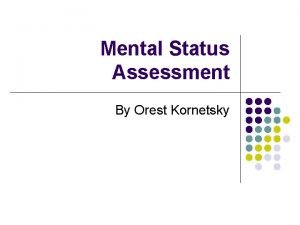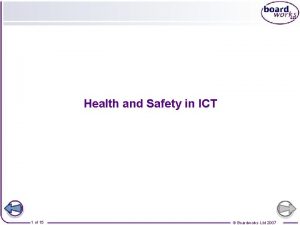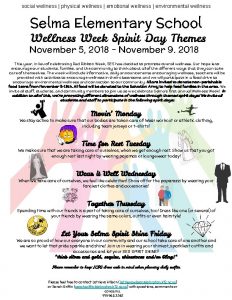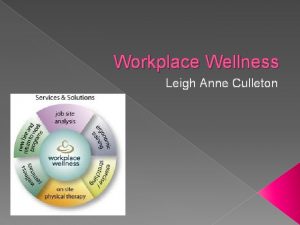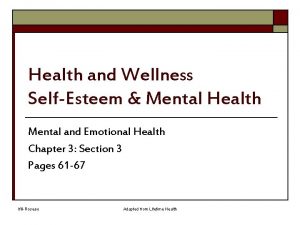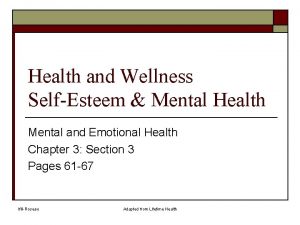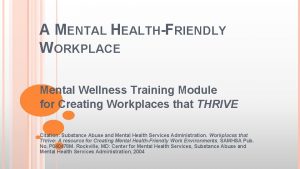MultiYear Mental Health and Wellness in the Workplace











- Slides: 11

Multi-Year Mental Health and Wellness in the Workplace Strategy & Federal Public Service Workplace Strategy Progress Update and Accomplishments Health Canada National Union-Management Consultation Committee May 16, 2017

Purpose • To provide a status update with respect to the implementation of Health Canada’s (HC) Multi-Year Mental Health and Wellness in the Workplace Strategy (the Strategy) and Federal Public Service Workplace Strategy. Context • This fiscal year marks Year 3 of the implementation of the Strategy, which includes the implementation of the National Standard for Psychological Health and Safety in the Workplace (the Standard). • HC continues to be amongst the lead Go. C departments with respect to the Federal Public Service Workplace Mental Health Strategy, which builds on the Clerk’s priority “Respectful Workplace with a focus on mental health”. 2

HC’s Multi-Year Mental Health and Wellness in the Workplace Strategy* Strategic Objectives Pillar 1 Promotion of resources and building skills Pillar 2 Implementation of the Standard Employees have the skills and knowledge to prevent and proactively address mental health and workplace wellness issues. Promotion of psychological well-being and prevention of harm to the psychological health of employees. Actions Engaging employees at all levels Building skills and knowledge through mandatory and non mandatory training Implementing the Standard with guidance from the Mental Health Commission of Canada’s Assembling the Pieces Encouraging positive and respectful workplace interactions through promotion of tools and resources Marketing and promoting Workplace Wellness tools, services, and resources Upholding anti-stigma workplaces through the Not Myself Today Campaign Demonstrating visible commitment and participating in mental health and wellness events Developing and implementing a Performance Measurement Framework The Standard’s 13 Psychosocial Risk Factors Psychological Support Civility & Respect Workload Management *Approved: July 6, 2015 Organizational Culture Clear Leadership & Expectations Psychological Competencies & Requirements Growth & Development Recognition & Reward Involvement and Influence Engagement Balance Psychological Protection of Physical Safety 3 3

Accomplishments Pillar 1 – Promotion of Resources and Building Skills 1. Senior Management Communications and Commitment Engaged staff via messages to staff, blogs and social networks emphasizing departmental commitment and building a culture of respect, increased knowledge and awareness. 2. Awareness & Events üHealth Talk Overwhelming participation during Health Talk 2, hosted by the DM, with panelists Clara Hughes, Mental Health advocate, and the Minister of Health, Dr. Jane Philpott. There has been a series of Go. C armchair participation, including HR Council (TBS), Canada School of Public Service, to share HC’s journey and progress to date. üMental Illness Awareness Week 2016 Launch of Year 2 of the Not Myself Today Campaign, the National Multi-Year Workplace Wellness Training Calendar, and the final two components of the Wellness Library Pilot: o Centralized Exercise Workstations in various locations; o the Mobile Library, which entails portable workplace wellness products that employees can borrow – available via an on-line catalogue; and o Life. Speak, launched in May 2016, a confidential bilingual e-learning platform that provides employees and their families with 24/7/365 access to physical and mental health, personal and professional growth resources. Since the launch… 2, 097 is the number of times active workstations were used. üBell Let’s Talk Interactive workshop led by a certified Positive Psychology Coach on Respect in the Workplace with a focus on mental health, and lived experience by a Mental Health First Aid facilitator. üScience Forum and Innovation Showcase Kiosks showcasing Workplace Wellness resources, including tool kits and one pagers. 182 items from the Mobile Library borrowed. 3, 600 Life. Speak videos viewed. 4

Accomplishments Pillar 1 – Promotion of Resources and Building Skills 3. Mandatory Workplace Wellness Training Highlights ü Building Blocks of Respect Branch-specific offerings resulted in significant increased in participation between November 2016 and February 2017. o Building Blocks of Respect for Managers – from 44% to 52% o Building Blocks of Respect for Employees – from 20% and 29% Online Training In most Branches: • more than 50% of Managers have taken Duty to Accommodate, and over 45% have completed Occupational Health and Safety; and • over 60% of employees at all levels have participated in the Creating Respectful Workplaces. ü Mental Health First Aid (MHFA) Excellent take up on MHFA training, nationally. o 126 sessions offered, and approximately 2, 240 HC employees have participated in 2016 -2017. o To date, more than 4, 300 HC employees successfully completed MHFA. Appendix A outlines the participation by Branch in classroom and online mandatory training. We will continue to: o Deliver Branch-specific mandatory workplace wellness training. o Work with Branches to deliver training offerings to employees in remote and isolated locations. o Leverage key events (i. e. Mental Illness Awareness Week, Bell Let’s Talk, town hall meetings) to continuously engage employees and provide them with tools and resources to build capacity to proactively address workplace wellness issues. 5

Accomplishments Pillar 2 – Implementation of the Standard – Branch Progress STEP 1 STEP 2 Building The • • Branch Project Leads established in all Branches Most Branches have launched People Management Charters, visions or policy statements o CFOB, CPAB, CSB, FNIHB, HECSB, PMRA, RORB, and SPB • All Branches continue to hold employee engagement sessions All Branches are conducting or have completed the analysis of their respective workplace wellness data and have identified areas for improvement Foundation What Are Your Opportunities ? STEP 3 What Are Your STEP 4 Implement the • • Objectives? Plan & Measure June 2, 2017: All-day Event for Branch Champions and Project Leads Some Branches have developed a Branch action Plan or integrating mental health and wellness activities to existing PSES, People Management or Branch Operational Plans o CPAB, CSB, HPFB and PMRA • • Two Branches have launched their respective Branch Action Plan o CPAB and CSB Other Branches have signalled that they will begin implementation of Branch Action Plans by September 2017 See Appendix B for detailed progress 6

Federal Public Service Workplace Mental Health Strategy Health Canada’s Accomplishments Strategic Goal 1: Change the Culture HC’s Accomplishments Appoint a psychological health and safety champion. • Departmental Workplace Well-being Champion identified. • A community of Branch Champions established throughout the Department promoting Workplace Wellness and the implementation of the National Standard for Psychological Health and Safety in the Workplace (the Standard). Raise awareness of mental health issues in the workplace and of available workplace health support services. • Senior management messages identify and promote the use of available resources. • Health Talks with the Minister, Mental Health Awareness Week, Bell Let’s Talk and Mental Health Week • Dedicated intranet site for Mental Health and Wellness tools and resources. • Best practices resources distributed at key departmental and federal public service-wide events (Workplace Wellness Resource One Pager, the Workplace Wellness Kit, Not Myself Today Campaign). Engage employees and Occupational Health and Safety (OHS) Committees and promote employee participation and psychological health and safety action and measures. • Mental Health and Workplace Wellness is a standing item at the National and HR Union Management Consultation Committees, as well as, the quarterly Departmental Occupational Health and Safety Policy Committee. • Specific Mental Health Fist Aid (MHFA) sessions offered to OHS Committee Members and Representatives. • On going employee engagement sessions, and establishment of Branch employee advisory committee. 7

Federal Public Service Workplace Mental Health Strategy Health Canada’s Accomplishments (cont’d) Strategic Goal 2: Build Capacity HC’s Accomplishments Identify organizational needs and provide employees with the proper training and tools to identify their own strength and areas where mental health can be improve to help face day to day stressor and challenges, including resiliency, support for each other and support for the public. • Mandatory and non mandatory Mental Health and Workplace Wellness training offered to all HC and PHAC employees via the National Multi-Year Workplace Wellness Training Calendar. Educate and equip managers and Occupational Health and Safety Committees with tools to ensure timely and appropriate identification of risks to reduce harm and appropriate response to employee needs and workplace incidents. • MHFA and Workplace Wellness related trainings offered to managers. Ensure early intervention and active case management, including stay-at-work and return-to-work practices. • A Disability Management Programs office provides a focal point for early intervention of LWOP cases, and active case management facilitating stay-at-work and return-to-work strategies. • A centralized service delivery model to respond to Duty to Accommodate related requests. Strategic Goal 3: Measure, Report, Continuously Improve • The Hazard Prevention Program currently underway will include the identification of psychosocial risks (under development). HC’s Accomplishments Review available data, current workplace programs, policies and practices to identify risks and areas for improvement. • Branch strengths and areas requiring improvement identified based on the Standard’s Psychosocial Risk Factors. Implement corrective action to address risks and improve psychological health and safety in the workplace. • Preliminary Performance Measurement Framework developed for EC-PM’s guidance and EC approval (under development). Establish regular transparent reporting around key data point and indicators. 8 8

Next Steps • Continue to work with the Branches to: § implement the Standard; and § provide support with respect to strategies to address upcoming PSEAS results. • Continue to pursue a completion rate of 100% for mandatory online training. • Develop and seek EC-PM’s endorsement of a Performance Measurement Conceptual Framework. • Seek HC-EC’s approval of the Framework. • Continue to align with the Federal Public Service Workplace Mental Health Strategy. 9

Appendix A Suite of Mandatory Workplace Wellness Training: Participation For 2016 -2017 Branches 1 Building Blocks of Respect in the Workplace Creating a Respectful Workplace Duty to Accommodate 1 A Workshop for Employees Managers 1 (Online) Helping Employees to Improve Performance 1 Mental Health First Aid Occupational Health and Safety 1 (Online) Values and Ethics in the Workplace for Managers 1 CFOB 75. 1% 70. 1% 87% 82. 7% 47. 2% 71. 6% 78. 7% 48. 8% CLRS 21. 8% 50% 27. 6% 33. 3% 8. 3% 27% 41. 7% 25% CPAB 42. 6% 69. 1% 59% 54. 5% 41. 8% 47. 7% 49. 1% 76. 4% CSB 46% 63. 8% 72. 8% 64. 7% 22. 6% 47. 1% 69. 1% 22. 4% FNIHB 30. 4% 59. 7% 81. 3% 69. 5% 38. 6% 32. 1% 75. 5% 15. 3% HECSB 52. 4% 64. 1% 59. 6% 41. 4% 35. 9% 49. 1% 44. 9% 38. 4% HPFB 44. 6% 51. 9% 73. 1% 52. 3% 23. 4% 22% 55. 2% 9. 7% LS 80. 6% 66. 7% 64. 7% 33. 3% 26. 4% 33. 3% PMRA 89. 6% 92. 6% 97. 3% 61. 1% 48. 1% 78. 7% 85. 2% 88. 9% RORB 60. 9% 73. 1% 89. 4% 67. 2% 46. 3% 66. 9% 57. 5% SPB 29. 9% 30. 2% 44. 3% 39. 6% 13. 2% 29. 9% 49. 1% 3. 4% Positions which have one or more subordinate positions reporting to them Prepared by: National Learning Centre, Human Resources Services Directorate, Corporate Services Branch Prepared on: 01 -Mar-2017 Data Sources: National Learning Programs Database, On-line Resource Centre, My. Account (CSPS) 10

Appendix B Progress by HC Branches, as per the Standard’s Implementation Steps (As of April 5, 2017) Implementation Steps Branches CFOB CPAB CSB FNIHB HECSB & CLRS HPFB PMRA RORB SPB Communicate Commitment to Implement the Standard F F F F P Develop Management Charter F F F N F F P Identify Branch Executive Champion(s) and Project Lead(s) F F F F F Establish Branch Employee Advisory Committee F F F F P Conduct Branch Analysis using Workplace Wellness Data F F F F P Identify Areas of Strength and Areas for Improvement based on the 13 Psychosocial Risk Factors F F F F P Target Areas for Improvement F F F F P Develop Multi-Year Branch Action Plan P F F P P Promote and engage employees to participate in Mental Heath and Wellness Training F F F F F Implement Branch Action, Performance Monitoring Process, and Management Review Process P F F P P P Monitor and Evaluate Outcomes N P P P N N Initiate corrective measures, as required. N P P P N N Step 1 Step 2 Step 3 Step 4 F Fully Completed P Partially Completed N Not Completed 11
 Law enforcement mental health and wellness act
Law enforcement mental health and wellness act Federal public service workplace mental health strategy
Federal public service workplace mental health strategy Federal public service workplace mental health strategy
Federal public service workplace mental health strategy Chapter 20 mental health and mental illness
Chapter 20 mental health and mental illness Chapter 3 health wellness and health disparities
Chapter 3 health wellness and health disparities Chapter 1 lesson 2 what affects your health
Chapter 1 lesson 2 what affects your health Understanding your health and wellness chapter 1
Understanding your health and wellness chapter 1 Workplace wellness bingo
Workplace wellness bingo Mental health jeopardy questions and answers
Mental health jeopardy questions and answers Mental wellness continuum framework
Mental wellness continuum framework Loose thought process
Loose thought process Ict health and safety
Ict health and safety
